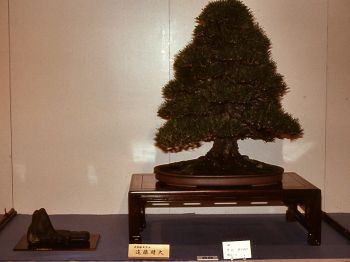
Larger version
As a new apprentice in Japan, I wanted to make a good impression on my host Mitsuyasan, so I took every step with care. To avoid making any mistakes, I moved with the speed of a snail. When I lifted trees, my goal was simply to get them from one place to another in their original condition.
One of the first trees I moved was a large kuro matsu (black pine). Yochan, my sempai (senior colleague), was the first to get a grip on this tree. As I bent down, my focus was on the pot and where I would place my hands. I failed to see that my left eye was on a direct collision course with the strong, full, and very sharp needles of an upper branch.
The sting of the needles kissing my eyeball woke me up. The offended orb quickly cried me a river to protest such an inconsiderate event. For the rest of the day, my left eye was in perpetual wink mode. By the next morning, all was well and the eye looked as good as new. So do as I say and not as I do... and keep an eye on where you put your eyes... or invest in a good pair of safety glasses. In Japan, I'm known as “Sheri” because they cannot pronounce Cheryl, but you can call me “Apprentice Clousseau”.
When it came time to restyle and repot a black pine that had just been displayed at the Kokufu show, I was thrilled (and relieved!) to be allowed to stand by and photograph the process as Mitsuyasan and Yochan performed surgery on the masterpiece tree.

After the show, the old needles were removed and a lime sulfur dormant spray was applied. Before the sensei (teacher) and his apprentice worked their magic, the copper wire that held the branches in position for the previous two years needed to be removed.
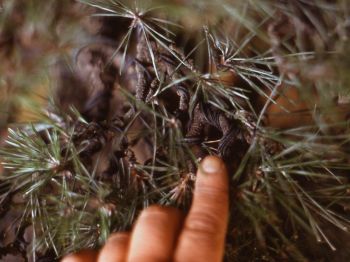
For at least thirty minutes, all of us – Mitsuyasan, Okusan (his wife), Yochan, and I – cut the curlicues of copper. Then Mitsuyasan left us to finish the job. After another thirty minutes, the tree was thirty pounds lighter and ready for a restyle... and a small fortune in copper was scattered on the workshop floor.
We three were proud of our thorough cleanup job until eagle-eyed Mitsuyasan promptly spotted several pieces of wire still on the tree. Oops. So much for three (well, two and a half) pairs of eyes...
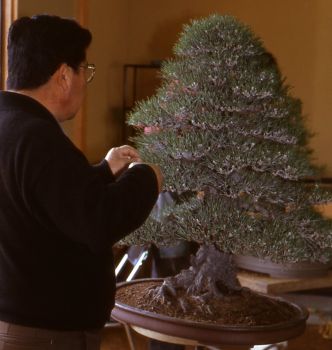
This masterpiece tree needed a master's touch, so Mitsuyasan was the only one to wield the hasami (scissors). He began by trimming branches to make this very symmetrical Christmas-tree-style informal upright a little more asymmetrical.
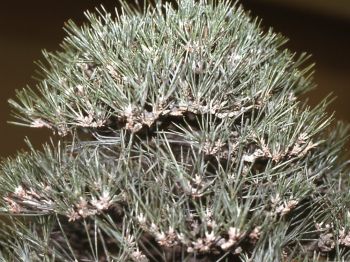
Mitsuyasan studied the apex for a while. The number of small branches that became the beautiful crown had thickened the trunk at the top. If left alone, the apex would continue to thicken, and the lovely tapered trunk (thick at the bottom, thinner at the top) would be lost.

So Mitsuyasan decapitated a masterpiece tree. The top five or six inches became trash. Now it was time to create a new apex.

Mitsuyasan used a chisel to cut a “V” notch in the trunk between a pair of small branches. One branch would become the apex. The other branch was an insurance policy in case the preferred apex did not survive the reposition skyward.

Mitsuyasan put two pieces of copper wire around the desired apex, down the trunk, and onto another branch.
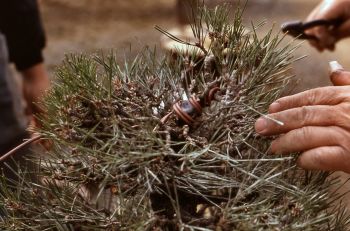
While Yochan stabilized the tree, Mitsuyasan gently brought the branch up into position, then stood back for a better view as he instructed Yochan to make some adjustments.
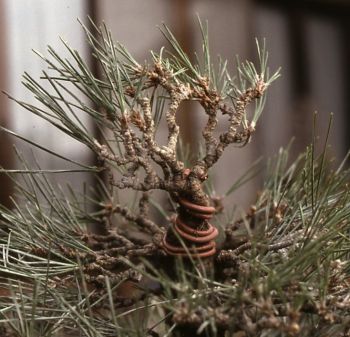
Once Mitsuyasan was sure the new apex was undamaged, he removed the other “potential” apex.

Although the branches on this new apex were small, Mitsuyasan wanted to begin the training process. Extra care is needed when wiring small branches, and the new apex was an important part of this makeover, so the master wired and positioned every branch.
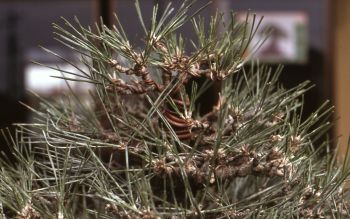
Once the training and shaping was done, it was time to repot. The tree was removed from the dark, shallow, wide-oval pot. I placed the pot on the ground next to the eight or ten other pots that we'd been working with that day.
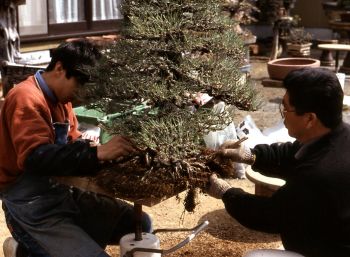
Mitsuyasan and Yochan used chopsticks to comb out old akadama (Japanese red clay growing medium) and trimmed the roots.

Yochan held the new pot in position as Mitsuyasan settled the root pad into its new home. But when Mitsuyasan glanced to his right and saw the tree's previous home (shallow brown tray) on the ground, he almost had heart failure. Yochan immediately knew what was wrong; he ran to the pot, gently lifted it, and very carefully placed it on the tatami mat inside the house.
Mitsuyasan had directed me to put pots on the ground – but this was no mere pot; it was a $100,000 antique masterpiece which had probably never touched the ground before I got my hands on it. Who knew? Obviously not me!
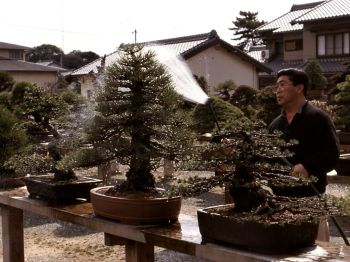
After a day of restyling and repotting, Mitsuyasan watered the tree until the runoff from the pot was clear and all the dust and fine particles were flushed out.
About one month later, the antique pot looked like a bubble-wrapped briefcase after Yochan packed it up. An elegant man in a suit was driven to our nursery, sat for the requisite tea, then was escorted to his restyled tree. He seemed quite pleased. After half an hour, he picked up his almost priceless package and went on his way. Yochan told me the client flew in just to check on his tree... and that the pot would be in the client's lap for the flight home.
I flew home with photos and memories... truly priceless.
[ Top of page | Go back | Go forward | "An Apprentice in Japan" contents | Site contents | Home | ]